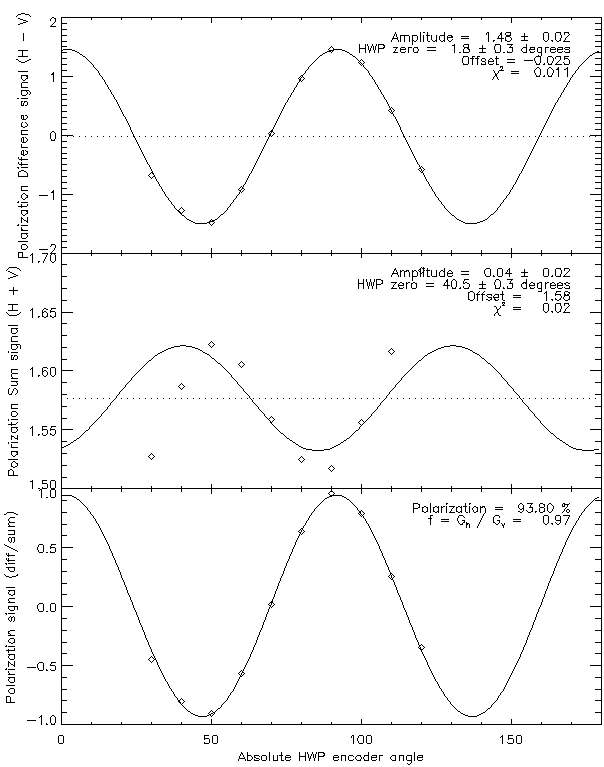

For the November run I tried measuring the polarization efficiency and HWP zero angle with a single calibration grid in 3 separate set-ups:
The plots below show an interesting systematic in this measurement.
The data on H-V and S = (H-V)/(H+V) vs. HWP angle show a measurable
offset along the y-axis. In addition, the H+V vs. HWP angle shows a
distinct periodicity. My working theory had been that this is due to
differences in the H and V gains (the January 2006 RGM has been
applied to the data). That is, the polarization f-factor is clearly
not unity. However, this hypothesis does consistently agree with all
the data. Or rather, the offset varies dramatically from dataset to
dataset, which is not what I would have expected for the f-factor. I
have outlined the theory below anyway in the hopes that someone else
might have some more ideas.
Consider the orthogonal signals are given by: Now we have From these equations we can see that if Gh =
Gv then H(θ) - V(θ) and S(θ) should be
symmetric about zero and H(θ) + V(θ) should be a constant.
The data are clearly not consistent with the assumption Gh
= Gv (especially for the low polarization found for set-up
2). The H(θ) - V(θ) and S(θ) data are consistent
with the relations above. However, the H(θ) + V(θ) data
exhibit a periodicity which differs from the expected 90°, but it
is also clearly not random. I currently have no explanation for this.
The zero-offsets and H+V period are consistent between the two
tests taken while the calibration grid wires were near-vertical.
However, when the wires are horizontal, not only does the polarization
level change, but so does the odd periodicity of H+V.
The H+V periodicity is not as obvious as in the differential data,
but I think it is there. The differential data is much noisier than
the non-differential data; I think the periodicity is just buried in
the noise. I strongly suspect that much of this noise is due to the
cold load not being replaced in the same spot (distance from
detectors) for each HWP angle. I suggest blocking the cold load with
warm eccosorb rather than removing/replacing the LN2 dewar for such
differential tests in the future.
If the gain-difference hypothesis alone is correct I would have
expected to get similar measurements for the f-factor despite the
different measurement techniques. It may be that there is just a
large error on the offset terms. But right now I can't rule out
something else.
H = 0.5 I Gh [ P (cos 4θ + 1) + (1-P) ] and
V = 0.5 I Gv [ P (1 - cos 4θ) + (1-P) ]
where I
is the total unpolarized intensity, P is the polarization, θ is
the HWP angle, and Gh,v are the H and V array gains. I
have assumed the arbitrary phase is zero for simplicity.
H - V = 0.5 I [ P (Gh + Gv) cos 4θ + (Gh - Gv) ],
H + V = 0.5 I [ P (Gh - Gv) cos 4θ + (Gh + Gv) ]
 |
 |